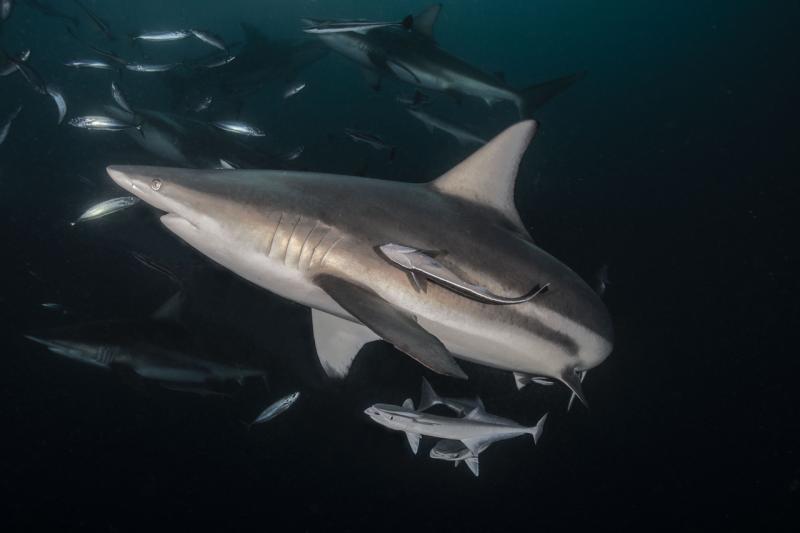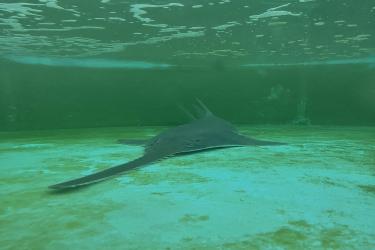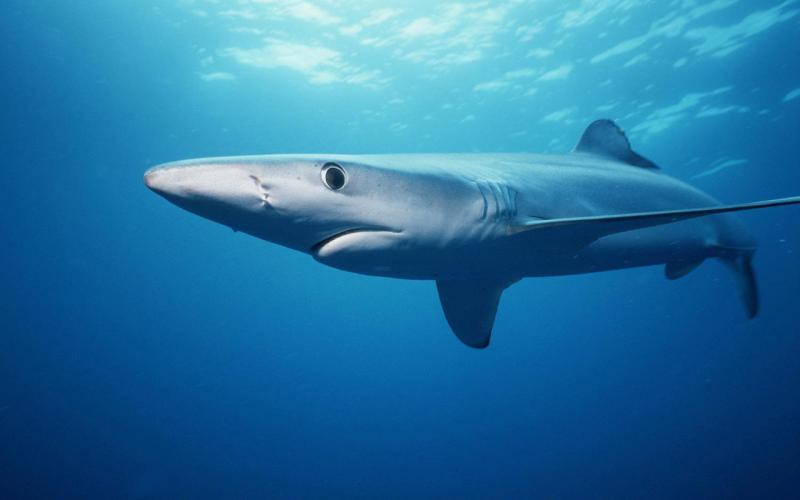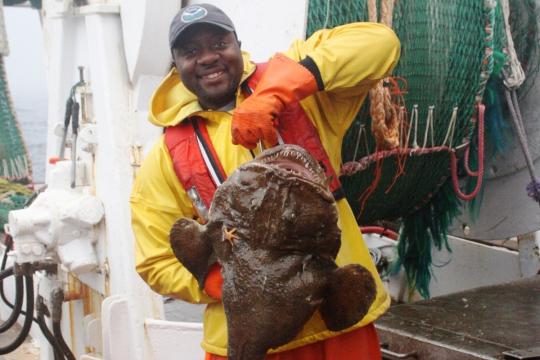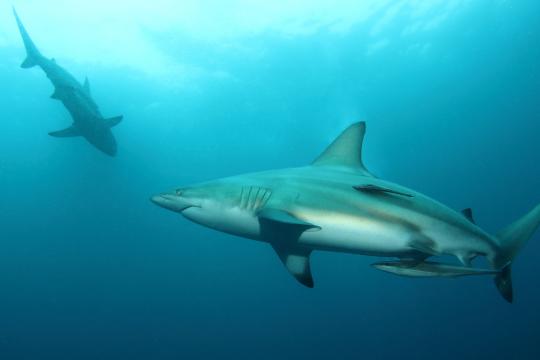Shark finning is often pointed to as a leading cause of decline in global shark populations. The wasteful practice has been illegal in United States federal waters for decades, though. Guy DuBeck, a highly migratory species fisheries management specialist, breaks down how a federal ban on shark finning works and the role it plays in protecting shark populations.
What is shark finning?
Shark finning is the practice of removing a shark’s fins and dumping the rest of the body at sea.
It’s important to remember that shark finning happens at sea. Fishermen or dealers who remove fins after bringing the whole shark to shore are not “finning” sharks. They are sustainably selling all parts of the shark.
How did shark finning come to be?
Fins are easier to transport than a whole animal. And while there are commercial uses for the rest of the shark, their meat is less profitable. That’s why some foreign fishermen will remove fins at sea.
Why would fishermen want to harvest fins at all?
Shark fins have a higher economic value than both shark meat and some other fish. So, fin sales are key to any commercial shark fishing operation. By selling the fins, U.S. fishermen are also making use of all parts of a sustainably harvested shark.
When did the United States ban shark finning?
NOAA Fisheries first banned shark finning in the Atlantic Ocean in 1993 because of the role it played in overfishing. Congress extended the ban to any vessel in the U.S. Exclusive Economic Zone with the Shark Finning Prohibition Act of 2000 and Shark Conservation Act of 2010.
Under these laws, fishermen must bring a shark to shore with all its fins naturally attached. That specific requirement is what makes our ban so effective. For example, it prevents fishermen from finning one shark and using staples or tape to attach the fins to another carcass on the boat. This is a loophole other countries have had to deal with.
The only exception to our requirement for fins to be naturally attached is Atlantic smooth dogfish. Fishermen can remove their fins at sea, but only if they meet a number of restrictions.
Why is there an exception for smooth dogfish?
The limited exception for smooth dogfish stems from unique fishery traits that make shark finning less of a concern. For example, smooth dogfish meat has almost the same economic value as their fins. This reduces the incentive for fishermen to dump the body at sea. Smooth dogfish also have a healthy population in the Atlantic and are easy to tell apart from other commercially harvested sharks. That makes enforcement easier.
Given these traits, and the higher harvest rate for smooth dogfish, it made sense to allow fishermen to prepare the shark at sea for sale at the dock.
Can fishermen sell shark fins?
Under federal law, U.S. fishermen are only allowed to remove and sell shark fins after bringing the animal to shore—as long as the shark was legally harvested. Most fins will end up as the main ingredient in shark fin soup, although international demand for shark fins has declined in recent years.
Some states and territories have passed partial or full bans on the possession, sale, trade, or distribution of shark fins. However, these laws do not prevent fishermen from harvesting federally managed sharks for their meat or other products. Laws like these banning the sale of fins are not needed to sustainably manage sharks in the United States.
What happens to the rest of a harvested shark?
There are a variety of commercial uses for sharks beyond their fins. Spiny dogfish, for example, are the primary species used in British fish and chips and other European dishes. Atlantic blacktip, thresher, and sharpnose shark meat is also sold in some seafood markets. Some pet foods can contain shark meat, while oils from shark livers are used in some cosmetic products and dietary supplements.
Aren’t sharks endangered? Why can they be caught and sold at all?
It’s a common misconception that all sharks are endangered. It’s true that overfishing, habitat loss, and other practices have greatly depleted some shark populations. But thanks to decades of strict fishery management, shark populations in the United States are on the rebound.
In fact, none of the 43 Atlantic shark species managed by NOAA Fisheries are listed as endangered in U.S. waters under the Endangered Species Act. Only the Oceanic whitetip and a distinct population segment of scalloped hammerhead typically found in the Caribbean are listed as threatened. Fishermen can keep these species only in limited situations.
Our sustainable shark fisheries are the result of management measures, like our shark finning ban. These measures incorporate the best available science to prevent overfishing while providing commercial and recreational fishing opportunities.
Doesn’t allowing shark fin sales undermine domestic and international efforts to prevent overfishing?
No, preventing U.S. shark fishermen from selling fins would not necessarily reduce the number of sharks taken from the ocean. It would only regulate which parts of a sustainably harvested shark can be used. It’s true that some commercial fishermen may stop harvesting sharks without the income that can come from fins. But we have more efficient fishery management tools like retention bans and quotas to boost population levels if a stock assessment revealed that was needed. The bottom line is that we are required by the Magnuson Stevens Act to prevent overfishing in our shark fisheries. We must do this regardless of whether shark fins are allowed to be sold or not.
A U.S. ban would also have little impact on the global fin market. The United States exports approximately 1 percent of all globally traded shark fins, and we import an even smaller percentage.
Our policy that sharks must be brought to shore with fins naturally attached, however, does have an important global role. It shows that it’s possible to have sustainable shark fisheries without banning the sale of fins. Responsibly participating in the global fin trade allows the United States to showcase our strong conservation and management practices overseas.
Are there downsides to a ban on the sale of shark fins?
Yes. Forcing fishermen to discard the fins of sharks caught in our sustainably managed fisheries would be wasteful. It would also mean less income for fishermen who work under some of the most robust and transparent environmental standards in the world.
What happens if a fisherman practices illegal shark finning?
Effective enforcement is a critical component of fisheries management. NOAA Fisheries conducts patrols both on and off the water. We also monitor vessel activities, conduct investigations, and use other measures, including emerging technologies, to ensure fishery management rules and regulations are followed.
Fishermen who participate in illegal shark finning could have their catch confiscated, lose their permits, be issued steep fines, or even face jail time.
Can shark fins from other countries be imported into the United States?
Yes, shark fins can be imported from other countries if the product meets the requirements of U.S. laws and regulations. That includes international agreements like the Convention on International Trade in Endangered Species and Wild Fauna and Flora—known as CITES. Several shark species have been recognized by CITES as in need of trade controls. Fins from those species can only be imported into the United States with appropriate CITES documentation from the exporting country. That documentation indicates that the fins were acquired legally in that country. It also shows that international trade will not be detrimental to the species’ survival in the wild.
Can we tell if fins imported into the United States were harvested illegally?
We are not able to determine what specific practices fishermen overseas used to harvest imported shark fins. However, those shark species imported into the United States with proper CITES documentation are required to be harvested legally and sustainably. Our Seafood Import Monitoring Program also allows us to verify that fins were harvested in line with the laws of the exporting country.
What is the United States doing to conserve shark populations internationally?
The United States is a global leader in shark conservation and sustainable management. In addition to promoting our naturally attached fins policy, we:
- Work with regional fisheries management organizations and other international bodies on global management and trade measures.
- Provide technical support for countries’ conservation efforts.
- Support shark identification training and data collection workshops.
- Collaborate on research to achieve science-based management measures.
